
|
Feedback Form

| Geometry Microworld for the Valiant Turtle |
MEASUREMENT: COMBINING ANGLE AND LENGTH
So far the activities have involved the children with either length or angle and the basic LOGO commands FD, BK, RT and LT. The children are now asked to combine distance and angle i.e. combine a FD (or BK) command with a RT (or LT) command. Once this can be done with confidence and some measure of accuracy, they have achieved full control of the turtle's movements.
ACTIVITY 3: MYRTLE GOES TO GRUB'S CAVE.
Return to the prehistoric landscape of FIG 5. Turn and move the turtle forward until it arrives at Grub's cave.
This activity is far more difficult than the previous ones since accuracy in both the turn and the distance travelled is called for. A slight inaccuracy in the angle turned can easily throw the turtle far off course.
There are two possible ways of approaching this problem:
- If the first attempt does not take the turtle to the cave the children can try again with the turtle in its new position.
- The turtle is returned to its original starting point and a new estimate
of turn and move is tried. Older children may find it useful to record
the various turtle instructions required to move the turtle to the cave.
If appropriate they could then write a simple journey procedure
e.g.: TO CAVE
RT 65
FD 100
END
Fig 9
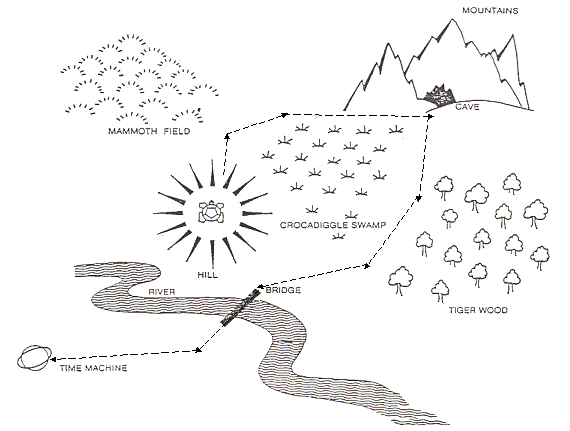
EXTENSION 3A: JOURNEY TO THE CAVE - A VARIATION
In this a prehistoric scene is created similar to that in FIG 9. To get to the cave it is necessary for the turtle to avoid dangerous areas like the 'crocadiggle swamp' and the 'sabre tooth tiger's lair'. This necessitates a more circuitous route and consequently poses a harder problem for the children to solve. A variety of journeys can be planned and undertaken, in a series of steps, avoiding any obstacles. This activity can be extended into a search for the shortest possible route and a return journey from the cave to the Time Machine.
EXTENSION 3B: MYRTLE GOES SWIMMING
Myrtle wants to go for a swim. This offers another opportunity for the children to practise combining linear and angular movements. The river used in activity 1 is made to meander and the turtle is placed in its centre (see FIG 10). The children program Myrtle to 'swim' downstream without touching either river bank.
Fig 10
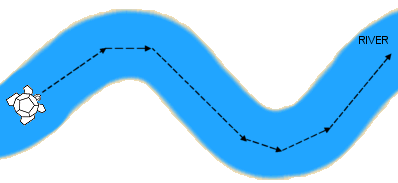
EXTENSION 3C: FANTASY JOURNEYS
An obvious variation on the last two activities is to have the children create their own landscape, which does not have to be prehistoric. It could be a moonscape, an underwater scene, a city, a fairytale land or a desert. The children could send Myrtle the Turtle on a journey through this fantasy land and write a simple story of her adventures: "Myrtle turned LEFT 90 and then went FORWARD 100 towards the Castle....."
EXTENSION 3D: TAKING THE TURTLE FOR A WALK
If space permits, the children can be encouraged to drive the turtle around a restricted area of the classroom, avoiding such natural obstacles as chair legs and visiting particular school friends etc..
EXTENSION 3E: TARGET GAME II
FIG 11: This is a variation on the activity Extension 1D. Various paper 'target' discs, 30 cm diameter, are placed around the room. The children should drive the turtle from one target to another until all the targets have been 'hit'.
Fig 11
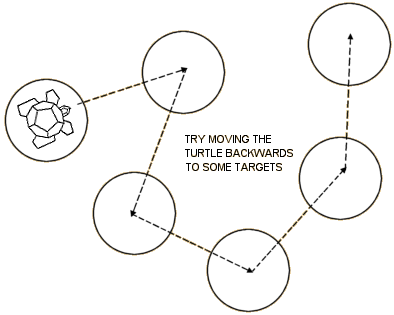
The turtle pen facility can be used to mark each disc. Once the turtle lands on the target the children should type HIT into the computer - the teacher should previously program the computer to draw a cross:
TO HIT
PD
FD 4
BK 2
RT 90
FD 2
BK 4
PU
FD 2
END
EXTENSION 3F: MAZE GAMES
Included in the Valiant Turtle's documentation is Myrtle the Turtle's first adventure which sets the scene for a maze game.
EXTENSION 3G: OBSTACLE COURSES
Make a simple obstacle course on the classroom floor. Mark starting and finishing points and then try to manoeuvre the turtle around the obstacles (FIG 12).
Fig 12
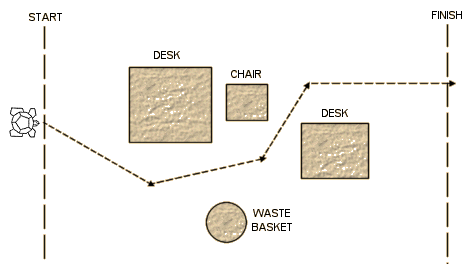
Variations on this can include a slalom course (FIG 13) or a more elaborate set-up which includes having to reverse the turtle (using the BK command) into a marked area (or garage?) and then move it forward to continue the course. This type of activity can provide the basis for numerous games which are very popular with children.
Fig 13
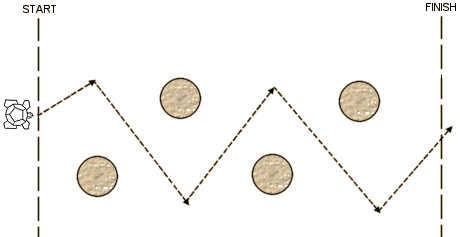
CAN A PATTERN BE SEEN IN THE PATHWAY?
CANA SIMPLE PROGRAM BE DEVELOPED?
EXTENSION 3H: HOW FAR DID MYRTLE TRAVEL?
If, in the above activities, the children record the turtle movements they can use the information to write a simple 'journey' procedure and calculate how far the turtle actually travelled. Can they distinguish between the linear and angular movements? Do they realize that angular movements do not form part of their calculation?
What is the distance if the turtle could travel directly to its destination?
Compare the actual distance travelled to the 'direct' distance. This can be done by drawing two lines adjacent to each other. Older children may be able to calculate a ratio for the two distances.
This type of activity serves to clarify the distinction between angular and linear movement. It also prepares the child for calculating perimeters using a turtle and provides a foundation of experience for the understanding of geometric vectors (see Extension 3I).
EXTENSION 3I: MYRTLE AND THE HARE
In this activity a version of Aesop's fable "The Tortoise and the Hare" can be used to provide a background story.
Myrtle and the Hare decide to have a race from A to B. Now Hare is very fast and rather conceited. Hare thinks to himself, "I can win this race very easily. I'll go and visit my friend at C before I go to B". Myrtle set off and went straight to B. When she got there Hare was nowhere to be seen. Eventually Hare arrived at B and was so surprised to see Myrtle. He couldn't understand how she beat him.
Can the children tell him?
Place three 40 cm diameter discs as shown in FIG 14. Use the turtle to measure the distance between A and B. There are two possible answers, the distance Myrtle travelled and the distance travelled by Hare.
Fig 14
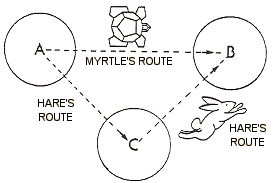
Embedded in this activity is the idea of a vector - a object which has both magnitude and direction. Vectors are. when treated formally at a later stage of education, a very powerful tool not only in geometry but also in physics and engineering. Although moves in turtle graphics do not take place in a fixed frame of reference, they can be regarded as vectors. With older children, who are already confident about handling quantities, the opportunity could be taken to discuss the idea of vector quantities and vector addition.
The process of vector addition can be illustrated by making the turtle repeat the activity, with the pen down on a large sheet of paper. The resulting diagram (FIG 15) is a graphical method of adding vectors.
Fig 15
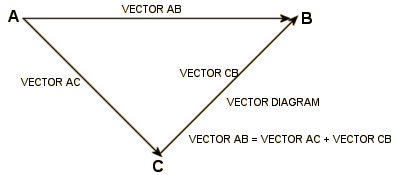
FURTHER IDEAS:
- Related activities from PENUP are Demolition Turtle, and the Shopping and Postman games.
- Using turtle commands, children can give instructions to each other,
in 'turtle language', for short journeys in the classroom, or further
afield.
This activity, 'playing turtle', is worth developing as it can prove to be a valuable tool in planning and "debugging" Logo procedures later on.
-
On a sheet of squared paper, mark starting and finishing
points on a rectangular grid as shown in FIG 16.
Fig 16
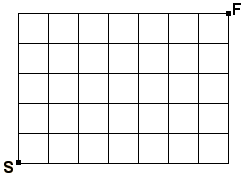
Travelling only along the lines. find out how many shortest routes there are from S to F.
Try the same activity with rectangles of different sizes.
Can the children find a pattern in your results?
REFERENCES:
WATT, D. Learning with LOGO. McGraw-Hill 1983.
Many of the references cited in the previous sections are also pertinent here.
| Back to index | Next page |
|---|